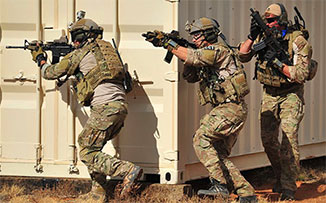Delta Force - Baghdad Air Strike
In the opening salvo of Operation Iraqi Freedom, March 2003, a team of Delta Force operators carried out a mission in the heart of the capital, Baghdad.
As allied forces prepared to initiate 'shock and awe', a massive opening salvo of air strikes against Baath leadership and other strategic targets, intelligence came across Pentagon planners' desks that Saddam himself would be in a specific place at a specific time. This was too good an opportunity to miss, even if attacking Saddam ahead of the main strike would tip their hand, lessening the subsequent 'shock and awe' somewhat. A plan was quickly drawn up to put a Special Operations team into the capital, in order to mark the target for the airstrike.
At their foward operating base in Kuwait, a small 6-man team of Delta operators from B Squadron, boarded a USAF MH-53j Pavelow III helicopter. The Delta team carried SOFLAM laser designators and secure encrypted satellite communications gear. As their helicopter took off, it was followed into the night by a second Pavelow, carrying USAF special tactics personnel, who would provide a secondary extraction force should Delta's chopper run into trouble.
Flying at ultra-low level to avoid Iraqi radar, the Special Operations Squadron pilots amanouvered the large helicopters along pre-planned routes that would take them around known air defences. Eventually, the Pavelows reached the insertion point. The moment the helicopter touched down in a remote desert spot, the small Delta team moved off its rear ramp, setting up a 360 degree security until the Pavelow III had exfilled away.
The team moved out to a pre-planned rendezvous point, where they were met by Intelligence Support Activity (ISA) operatives. Dressed as Iraqi civilians, the ISA agents made contact with the Delta team and drove them into Baghdad in two Mercedez. The ISA had been operating covertly in the Iraqi capital for some time, gathering intelligence on likely targets, establishing safe houses, procuring transport, fake idenitifcation papers and water and preparing exit procedures. The Delta/ISA team made into Baghdad without incident, where they set up in a safe house.

Intelligence had pinpointed a nearby restaurant as a place where Saddam and other Baath party high-ups frequently met and where intelligence beleived they would again shortly.. Delta set up an observation position on the roof of a building down the block from the restaurant. When a convoy, including a RV-type vehicle of the type used by Saddam, pulled up outside the restaurant, the pre-arrange plan sprung into action. As the occupants of the convoy entered the restaurant, one of the Delta Force operatives aimed the laser beam from the SOFLAM designator at the restaurant. As he painted the target, one of his colleagues got on the secure stacomms unit and made contact with a USAF B2 Stealth bomber which was circling high above the city, undetected by Iraqi radar. The Delta SATCOM operator confirmed the target and called for the strike. The B2 released a large 'bunker buster' bomb, which glided down, homing in on the reflected laser energy from the SOFLAM. 2 minutes later, the restaurant exploded in a shower of bricks and mortar and dust.
Delta used the pandemonium caused by the air strike to make their escape, driven out of the city by the ISA, back out into the desert and their helicopter pick-up point.
The operation had been carried out with typical Delta efficiency. It later transpired that Saddam had not been present at the scene of the airstrike, although this failing was one of intelligence, rather than execution of the mission.





